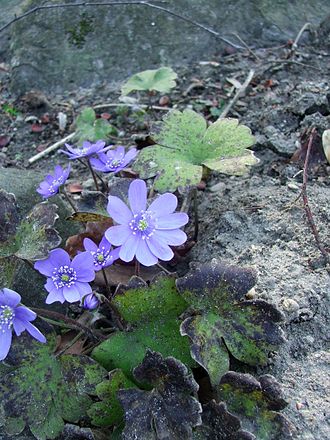Hepatica
Hepatica is a genus of herbaceous perennials in the family Ranunculaceae, commonly known as liverworts, liverleaves, or liverwort. The genus is native to temperate regions of the Northern Hemisphere, including North America, Europe, and Asia. The name "Hepatica" is derived from the Greek word for liver, due to the liver-shaped leaves of some species.
Description
Hepatica plants are small, typically growing to a height of 5-15 cm. They have basal leaves that are leathery and often three-lobed, resembling the shape of a liver. The leaves are evergreen in some species, providing year-round ground cover. The flowers of Hepatica are among the first to bloom in spring, appearing before the leaves fully develop. They come in a variety of colors, including white, pink, purple, and blue.
Habitat
Hepatica species thrive in deciduous woodlands, often found in shaded or semi-shaded areas with rich, well-drained soil. They are commonly found in regions with a temperate climate, where they benefit from the leaf litter that provides nutrients and protection during the winter months.
Species
There are several species within the genus Hepatica, including:
- Hepatica nobilis - Common Hepatica
- Hepatica acutiloba - Sharp-lobed Hepatica
- Hepatica americana - Round-lobed Hepatica
Cultivation
Hepatica is a popular plant for gardening and landscaping due to its early spring flowers and attractive foliage. It prefers a shaded location with moist, well-drained soil. Hepatica can be propagated by seed or by division of the clumps after flowering.
Uses
Historically, Hepatica was used in traditional medicine to treat liver ailments, inspired by the Doctrine of Signatures, which suggested that plants resembling body parts could be used to treat ailments of those parts. However, there is no scientific evidence to support its efficacy in treating liver diseases.
Conservation
Some species of Hepatica are considered threatened or endangered in certain regions due to habitat loss and over-collection. Conservation efforts are focused on protecting natural habitats and promoting sustainable cultivation practices.
Related Pages
Categories
Transform your life with W8MD's budget GLP-1 injections from $125.
W8MD offers a medical weight loss program to lose weight in Philadelphia. Our physician-supervised medical weight loss provides:
- Most insurances accepted or discounted self-pay rates. We will obtain insurance prior authorizations if needed.
- Generic GLP1 weight loss injections from $125 for the starting dose.
- Also offer prescription weight loss medications including Phentermine, Qsymia, Diethylpropion, Contrave etc.
NYC weight loss doctor appointments
Start your NYC weight loss journey today at our NYC medical weight loss and Philadelphia medical weight loss clinics.
- Call 718-946-5500 to lose weight in NYC or for medical weight loss in Philadelphia 215-676-2334.
- Tags:NYC medical weight loss, Philadelphia lose weight Zepbound NYC, Budget GLP1 weight loss injections, Wegovy Philadelphia, Wegovy NYC, Philadelphia medical weight loss, Brookly weight loss and Wegovy NYC
|
WikiMD's Wellness Encyclopedia |
| Let Food Be Thy Medicine Medicine Thy Food - Hippocrates |
Medical Disclaimer: WikiMD is not a substitute for professional medical advice. The information on WikiMD is provided as an information resource only, may be incorrect, outdated or misleading, and is not to be used or relied on for any diagnostic or treatment purposes. Please consult your health care provider before making any healthcare decisions or for guidance about a specific medical condition. WikiMD expressly disclaims responsibility, and shall have no liability, for any damages, loss, injury, or liability whatsoever suffered as a result of your reliance on the information contained in this site. By visiting this site you agree to the foregoing terms and conditions, which may from time to time be changed or supplemented by WikiMD. If you do not agree to the foregoing terms and conditions, you should not enter or use this site. See full disclaimer.
Credits:Most images are courtesy of Wikimedia commons, and templates, categories Wikipedia, licensed under CC BY SA or similar.
Translate this page: - East Asian
中文,
日本,
한국어,
South Asian
हिन्दी,
தமிழ்,
తెలుగు,
Urdu,
ಕನ್ನಡ,
Southeast Asian
Indonesian,
Vietnamese,
Thai,
မြန်မာဘာသာ,
বাংলা
European
español,
Deutsch,
français,
Greek,
português do Brasil,
polski,
română,
русский,
Nederlands,
norsk,
svenska,
suomi,
Italian
Middle Eastern & African
عربى,
Turkish,
Persian,
Hebrew,
Afrikaans,
isiZulu,
Kiswahili,
Other
Bulgarian,
Hungarian,
Czech,
Swedish,
മലയാളം,
मराठी,
ਪੰਜਾਬੀ,
ગુજરાતી,
Portuguese,
Ukrainian
Contributors: Prab R. Tumpati, MD





